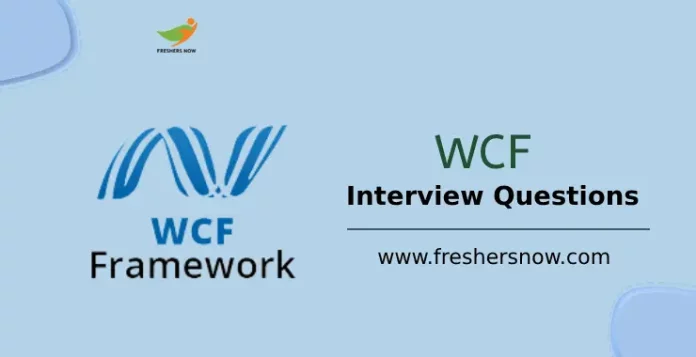
WCF Interview Questions and Answers: WCF (Windows Communication Framework) is a Microsoft technology for developing distributed applications. It supports various communication methods and interoperability with non-Microsoft applications. WCF services can be hosted in IIS, self-hosted, or through the Windows Activation Service.
To excel in WCF interviews, it’s crucial to master the Latest WCF Interview Questions. Our Top 50 WCF Interview Questions and Answers collection is tailored to help you succeed by providing comprehensive coverage of various topics and scenarios. Boost your knowledge and preparation for WCF Interview Questions for Freshers with these valuable resources.
★★ Latest Technical Interview Questions ★★
WCF Technical Interview Questions
Explore the latest Top 50 WCF Interview Questions and Answers, covering various topics and catering to both technical and fresher candidates. Gain valuable insights to excel in WCF interviews.
Top 50 WCF Interview Questions and Answers
1. What is WCF (Windows Communication Foundation) and what are its key features?
WCF is a Microsoft technology used for developing distributed applications. Its key features include interoperability, support for various communication methods, hosting flexibility, and integration with multiple protocols and security mechanisms.
2. Explain the difference between WCF and ASMX web services.
WCF is the successor to ASMX web services and offers advanced features such as interoperability, support for multiple protocols, and hosting flexibility. WCF provides a unified programming model for building distributed applications, whereas ASMX web services are limited to HTTP protocol and offer less flexibility.
3. Why should one use WCF services?
Here are some reasons to use WCF services:
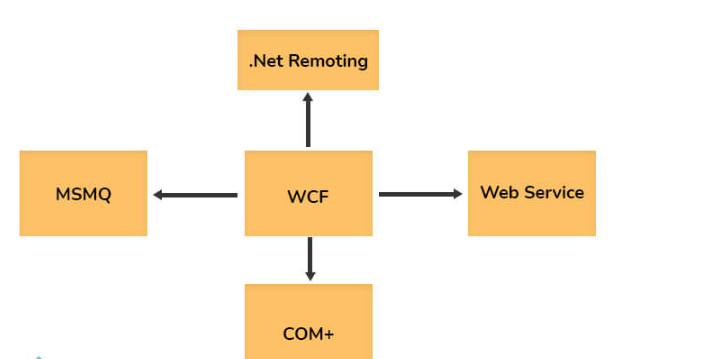
- Easy to use and flexible.
- Options for hosting in Windows Activation Service, IIS, and self-hosting.
- Supports multiple protocols: HTTP, WS-HTTP, TCP, P2P, MSMQ, and named pipes.
- Utilizes TCP protocol for high-performance binary message exchange.
- Enables communication and data exchange using the chat functionality.
- Provides traffic reports for monitoring the service.
- Offers security services for transaction processing.
- Uses XML format over HTTP for interoperable message exchange.
- Facilitates real-time data exchange over secure networks.
4. Differences between WCF and RESTful services in terms of architectural principles
| WCF | RESTful Services |
|---|---|
| Follows a service-oriented architecture (SOA) | Follows Representational State Transfer (REST) principles |
| Supports both SOAP-based and RESTful services | Primarily focuses on RESTful architectural style |
| Offers more advanced features and capabilities | Emphasizes simplicity, scalability, and loose coupling |
| Provides support for various protocols and | Uses HTTP as the underlying protocol with standard HTTP methods |
| standards such as WS-* | (GET, POST, PUT, DELETE) and RESTful conventions |
5. What are the different types of bindings available in WCF?
WCF provides various bindings such as BasicHttpBinding, WsHttpBinding, NetTcpBinding, NetNamedPipeBinding, and NetMsmqBinding. Each binding offers different features and is suitable for specific communication scenarios.
6. Write the core components of WCF?
The three core components of WCF are as follows:
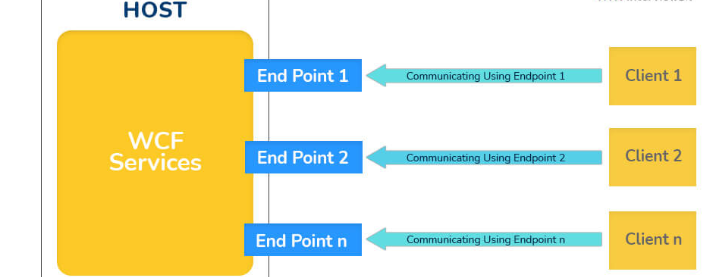
Service class:
- Runtime layer that handles behaviors when the service is running.
- Throttling controls the number of processed messages, adjustable as the service grows.
Endpoint:
- WCF Service exposes a set of endpoints.
- Endpoints consist of Address, Binding, and Contract components.
- Endpoints serve as portals for communication with the outside world.
Hosting Environment:
- The host application manages the service’s lifetime.
- Self-hosting or management of services is possible through the existing hosting process
7. What is the syntax for defining a WCF service contract interface?
In WCF, a service contract interface is defined using the [ServiceContract] attribute at the interface level.
8. Explain Tracing in WCF.
- WCF tracing allows for diagnosing and analyzing data and fault messages.
- Tracing provides better insights into application behavior and flows compared to debugging.
- It offers a detailed account of application components, including faults, exceptions, system events, and operation calls.
- WCF tracing is not enabled by default and needs to be configured with switch values and trace listeners.
- WCF tracing involves four steps: enabling tracing, configuring trace sources, specifying trace listeners, and analyzing trace output.
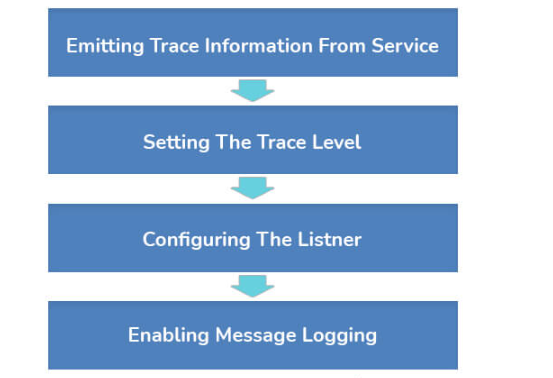
9. How do you define a WCF operation contract method syntax?
In WCF, an operation contract method is defined within the service contract interface using the [OperationContract] attribute.
10. What is the syntax for specifying the binding configuration in a WCF endpoint?
In the WCF endpoint configuration, the binding configuration is specified using the <binding> element within the <bindings> section.
11. Differences between WCF and Web API in terms of communication style
| WCF | Web API | |
|---|---|---|
| Style | SOAP-based communication | RESTful communication |
| Protocols | Supports multiple protocols (HTTP, TCP, etc.) | Primarily based on HTTP |
| Message | XML-based messages | JSON-based messages |
| Flexibility | More configuration options and features | Lightweight and flexible for simple scenarios |
12. How do you specify the contract for a WCF service endpoint in the configuration file?
In the WCF endpoint configuration, the contract for a service endpoint is specified using the contract attribute within the <endpoint> element.
13. Name different instance modes in WCF.
WCF provides three ways to control WCF instance creation as follows:
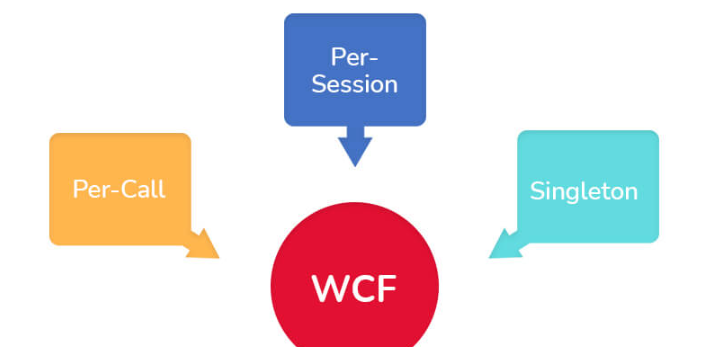
Per Call:
- A new instance is created for each request from the same or a new client.
- Every request is treated as a new request.
- Efficient in terms of memory usage.
- Session needs to be maintained.
Per Session:
- A new instance is created for each new client session.
- Object scope corresponds to the session scope.
- Multiple requests within the same session share the same instance.
- Efficient in terms of memory usage compared to single instance mode.
Single Instance:
- Only one instance is created for all requests, regardless of the client.
- The same instance is shared across multiple requests.
- Least efficient in terms of memory usage.
- No need to maintain separate instances for each request or session
14. What is the syntax for configuring a WCF client endpoint programmatically?
To configure a WCF client endpoint programmatically, you use the EndpointAddress and BasicHttpBinding classes to specify the endpoint address and binding, respectively.
15. How do you define a WCF service behavior using the configuration file syntax?
In the WCF service configuration, a service behavior is defined using the <behavior> element within the <behaviors> section.
16. What is the syntax for enabling metadata exchange in a WCF service configuration?
To enable metadata exchange in a WCF service configuration, you include the <serviceMetadata> element within the <behaviors> section and set the httpGetEnabled attribute to true.
17. Differences between WCF and ASP.NET Core in terms of cross-platform compatibility
| WCF | ASP.NET Core | |
|---|---|---|
| Cross-platform | Limited support, primarily Windows-based | Fully cross-platform (Windows, Linux, macOS) |
| Lightweight | Heavier framework with additional dependencies | Lightweight and modular framework |
| Hosting options | Limited hosting options (IIS, self-hosting) | Can be hosted in various environments (IIS, Kestrel) |
| Development model | Traditional .NET framework development model | Modern development model with emphasis on containers |
18. How do you specify the endpoint address in the WCF client configuration?
In the WCF client configuration, the endpoint address is specified using the address attribute within the <endpoint> element.
19. What is the syntax for configuring a WCF service to use a specific binding in the configuration file?
To configure a WCF service to use a specific binding in the configuration file, you specify the binding configuration name using the bindingConfiguration attribute within the <endpoint> element.
20. How do you define a WCF service contract with multiple operations in the configuration file?
In the WCF service configuration, a service contract with multiple operations is defined using the <serviceContract> element within the <service> element and each operation is specified using the <operation> element
21. Differences between WCF and SignalR in terms of real-time communication
| WCF | SignalR | |
|---|---|---|
| Communication | Duplex communication pattern | Full-duplex communication |
| Supported platforms | Limited to the Windows platform | Cross-platform (Windows, Linux, macOS) |
| Protocols | Supports multiple protocols (HTTP, TCP, etc.) | Primarily based on WebSockets and HTTP |
| Scalability | Limited scalability in large-scale scenarios | High scalability and real-time updates |
22. How does WCF support interoperability with non-Microsoft platforms?
WCF supports interoperability with non-Microsoft platforms through the use of standard protocols such as SOAP, XML, and HTTP. It allows communication with applications developed using different technologies and platforms, enabling seamless integration in heterogeneous environments.
23. What is the purpose of contracts in WCF?
Contracts in WCF define the communication interface between the service and the client. They specify the operations, data types, and message formats exchanged between them, ensuring a consistent and agreed-upon interaction between the parties involved.
24. Describe the process of hosting a WCF service in IIS.
To host a WCF service in IIS, you need to create a WCF service project and configure the service endpoints and bindings on the web. config file, and deploy the service to the IIS server. IIS acts as the hosting environment, handling incoming requests and forwarding them to the appropriate WCF service.
25. How can you enable message logging in WCF?
Message logging in WCF can be enabled by configuring the appropriate settings in the WCF service configuration file. By specifying the required logging options, such as log location, verbosity level, and message formats, you can capture and store incoming and outgoing messages for debugging and auditing purposes.
26. Differences between WCF and gRPC in terms of supported protocols
| WCF | gRPC | |
|---|---|---|
| Protocols | Supports multiple protocols (HTTP, TCP, etc.) | Primarily based on HTTP/2 and Protocol Buffers |
| Platform support | Primarily Windows-based | Cross-platform (Windows, Linux, macOS) |
| Language support | Supports multiple programming languages | Primarily supports C# and other languages |
27. Explain the concept of endpoints in WCF.
Endpoints in WCF represent the communication channels through which clients interact with the WCF service. Each endpoint has a unique address, binding, and contract, defining the location, communication protocol, and service interface for the clients to connect and communicate with the service.
28. What are the different security mechanisms available in WCF?
WCF provides various security mechanisms such as transport security, message security, and transport message security. Transport security secures the communication channel, while message security secures the individual messages by encrypting and signing them. Transport message security combines both transport and message security for enhanced protection.
29. Differences between WCF and MQTT in terms of messaging patterns
| WCF | MQTT | |
|---|---|---|
| Messaging pattern | Point-to-point and publish-subscribe | Publish-subscribe pattern |
| Protocols | Supports multiple protocols (HTTP, TCP, etc.) | Primarily based on the MQTT protocol |
| Lightweight | Comparatively heavier framework | Lightweight protocol for constrained devices |
30. How does WCF handle fault exceptions?
WCF handles fault exceptions by using FaultContracts. FaultContracts are defined in the service contract and specify the types of exceptions that can be thrown by the service. When a fault exception occurs, WCF serializes the fault information and sends it back to the client, allowing appropriate error handling and recovery.
31. What is the purpose of the DataContract and DataMember attributes in WCF?
The DataContract attribute is used to mark a class as a data contract in WCF. It specifies that the class will be serialized and deserialized during communication. The DataMember attribute, on the other hand, is applied to the members (properties or fields) of a data contract class to indicate that they should be included in the serialization process.
32. Explain the concept of throttling in WCF.
Throttling in WCF refers to the mechanism of controlling the number of concurrent requests and resources consumed by a service. It helps prevent service abuse and ensures fair usage by limiting factors such as maximum concurrent calls, maximum concurrent instances, and maximum concurrent sessions.
33. Differences between WCF and GraphQL in terms of data querying and manipulation
| WCF | GraphQL | |
|---|---|---|
| Data querying | Traditional request-response model | Allows flexible and precise data querying |
| Data manipulation | Primarily through service operations | Supports mutations for data manipulation |
34. How can you handle concurrency in WCF?
WCF provides several concurrency modes to handle concurrent requests. These modes include Single, Multiple, and Reentrant. Single mode allows only one request at a time, Multiple modes allow multiple requests concurrently, and Reentrant mode allows reentrant calls within the same context.
35. What are the advantages of using WCF over traditional .NET remoting?
WCF offers several advantages over traditional .NET remoting, such as improved interoperability, support for multiple protocols, hosting flexibility, and enhanced security features. WCF also provides a unified programming model for building distributed applications, making it easier to develop and maintain.
36. How can you enable reliable messaging in WCF?
Reliable messaging in WCF ensures that messages are delivered reliably and in the correct order. It can be enabled by using the ReliableSession binding element in the configuration file. By setting the reliable session properties, such as inactivity timeout and ordered delivery, you can ensure reliable message transmission.
37. Differences between WCF and Apache Kafka in terms of event-driven communication
| WCF | Apache Kafka | |
|---|---|---|
| Communication model | Service-oriented architecture (SOA) | Event-driven architecture |
| Data distribution | Primarily point-to-point communication | Distributed publish-subscribe messaging |
| Scalability | Limited scalability in large-scale scenarios | High scalability and fault-tolerance |
38. Explain the role of behaviors in WCF.
Behaviors in WCF are used to modify or extend the runtime behavior of a service or client. They can be used to implement additional functionality such as message inspection, error handling, and service throttling. Behaviors can be applied at various levels, including service, endpoint, and operation.
39. What is the difference between basicHttpBinding and wsHttpBinding?
basicHttpBinding is binding in WCF that supports basic web services communication over HTTP. It uses SOAP 1.1 messaging and is suitable for interoperability with older web services. On the other hand, wsHttpBinding supports advanced web services communication over HTTP. It uses SOAP 1.2 messaging and offers features like reliable sessions, transactions, and security.
40. Differences between WCF and AMQP (Advanced Message Queuing Protocol) in terms of messaging standards
| WCF | AMQP | |
|---|---|---|
| Messaging standard | Proprietary messaging format | Open messaging standard |
| Interoperability | Limited interoperability with non-Microsoft systems | Interoperable across different platforms and technologies |
| Message routing | Supports different message routing options | Flexible and sophisticated message routing capabilities |
41. How can you handle large data transfers in WCF?
WCF provides options to handle large data transfers, such as using streamed transfer mode or implementing message chunking. Streamed transfer mode allows the transfer of large data by breaking it into smaller chunks. Alternatively, you can implement message chunking by dividing the data into smaller parts and sending them as separate messages.
42. What is the purpose of the ServiceContract attribute in WCF?
The ServiceContract attribute is used to define the service contract interface in WCF. It marks an interface as a service contract and specifies the operations and messages that the service exposes to clients. It helps in defining the communication interface and establishing the contract between the service and its clients.
43. Explain the concept of message inspectors in WCF.
Message inspectors in WCF allow you to inspect and modify messages at various stages of the message processing pipeline. By implementing custom message inspectors, you can intercept incoming and outgoing messages, analyze or modify their content, and perform additional operations such as logging or validation.
44. Differences between WCF and Apache Thrift in terms of cross-language compatibility
| WCF | Apache Thrift | |
|---|---|---|
| Cross-language | Supports multiple .NET languages | Cross-language support (Java, C++, etc.) |
| Platform support | Primarily Windows-based | Cross-platform (Windows, Linux, macOS) |
| Performance | Comparatively slower performance | High-performance and efficient protocol |
45. How can you implement duplex communication in WCF?
Duplex communication in WCF can be implemented using the duplex contract, which allows the service to send messages back to the client. It involves defining callback contracts, establishing a duplex channel, and implementing callback methods on the client to receive the service responses.
46. What are the different instancing modes available in WCF?
WCF supports three instancing modes: PerCall, PerSession, and Single. PerCall creates a new service instance for each client request, PerSession creates a single instance for each client session, and Single creates a single instance shared among all clients.
47. Explain the concept of message security in WCF.
Message security in WCF involves securing individual messages by encrypting and signing them. It ensures confidentiality and integrity during message transmission. Message security can be implemented by configuring the appropriate security settings in the binding and using certificates or other security credentials.
48. How can you handle transactions in WCF?
WCF provides support for handling transactions through the System. Transactions namespace. You can use attributes such as TransactionFlow and OperationBehavior to enable and control transactional behavior in WCF services. Additionally, you can use distributed transactions with WCF to coordinate transactions across multiple resources.
49. What is the purpose of the Proxy class in WCF?
The Proxy class in WCF is generated automatically when creating a client for a WCF service. It acts as a client-side representation of the service contract, allowing the client to invoke operations on the service. The Proxy class handles communication with the service, including message serialization and deserialization.
50. Explain the role of metadata in WCF.
Metadata in WCF describes the service and its endpoints, including information about the operations, data types, bindings, and contracts. It allows clients to discover and understand the service at runtime. Metadata can be exposed through various protocols, such as HTTP or TCP, and can be consumed by clients to generate service proxies.
This collection of Top 50 WCF Interview Questions and Answers is a valuable resource for job seekers preparing for technical interviews in WCF, providing comprehensive knowledge and insights. Reliable sources like freshersnow.com can help individuals stay updated on the latest developments in the field.



